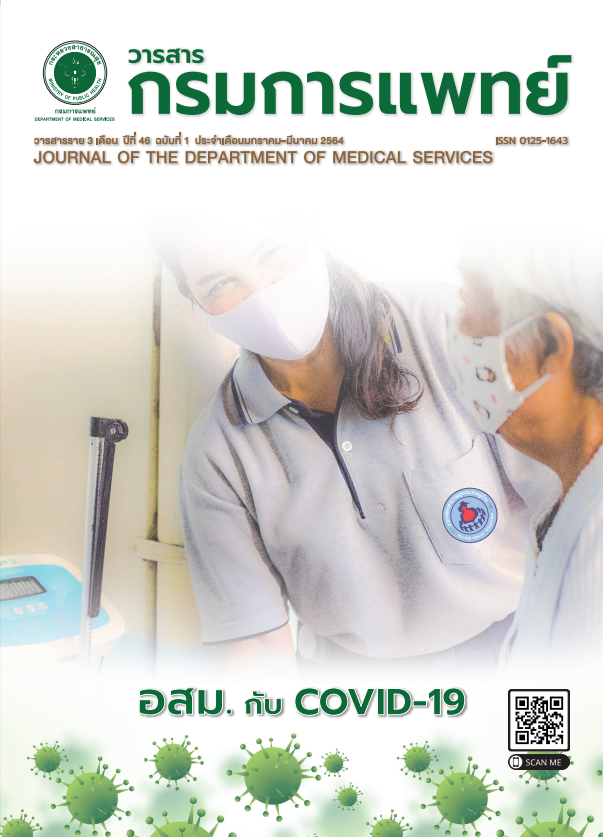Quantity and Value of Injectable Antibacterial Drugs Prescribed at In-patient Department of Rajavithi Hospital
Keywords:
Injectable antibacterial drugs, Defined Daily DoseAbstract
Background : According to the World Health Organization (WHO), the combination of increasing bacterial drug resistance and declining efficacy of antibacterial drugs has resulted in a higher mortality rate and higher healthcare expenditure.Objectives : To determine the defined daily doses (DDD) and the values of injectable antibacterial drugs prescribed at Rajavithi Hospital in fiscal 2015-2018.Method : Data on injectable antibacterial drugs prescriptions at In-patient Department of Rajavithi Hospital over the fiscal year of 2015-2018 was retrieved from the Rajavithi Hospital’s RHIS database. Defined daily doses and values of injectable antibacterial drugs prescribed during that period were calculated.Results : The total value of injectable antibacterial drugs prescribed over the fiscal year of 2015-2018 was 258,243,237 THB. The total values of injectable antibacterial drugs prescribed in each of those fiscal years were 61,008,627 THB, 61,176,368 THB, 67,282,391 THB and 68,775,852 THB, respectively. The top three highest values of injectable antibacterial groups were carbapenems (83,414,218 THB or 32.30%), cephalosporins (45,587,096 THB or 17.62%) and quinolones (25,112,416 THB or 9.72%). The top three highest values of injectable antibacterial drugs were meropenem (70,042,934 THB or 27.12%), clindamycin (21,948,800 THB or 8.50%) and ceftazidime (21,852,513 THB or 8.46%). The total value of injectable antibacterial drugs prescribed over the fiscal year of 2015-2018 increased at an average rate of 3.18% per year. The top three highest values of injectable antibacterial groups with highest DDD were cephalosporins (1194.30), carbapenems (600.91) and sulfonamides (474.80). The top three highest values of injectable antibacterial drugs with highest DDD were meropenem (532.58), sulfamethoxazole/ trimethoprim (474.80) and ceftriaxone (421.60).Conclusion : Both quantity and value of injectable antibacterial drugs prescribed keep rising over the fiscal year of 2015-2018, especially the carbapenems group.
References
Department of Health Service Support, Health Administration Devision, Office of Permanent Secretary.Antimicrobial resistance hospital management guideline. 1st edition. Nonthaburi: Health service press;2016.
Sumpradit N, Suttajit S, Poonplosup S, Chuancheun R,Prakongsai P. Landscape of antimicrobial resistance situations and actions in Thailand. Bangkok: Aksorn graphic and design publishers; 2015.
O’Neill J. Review on antimicrobial resistance. [Internet]. [cited 2019 Feb 28]. Antimicrobial resistance: Tackling a crisis for the health and wealth of nation 2014. Available from: https://amr-review.org/Publications.html/.
Phumart P, Phodha T, Thamlikitkul V, Riewpaiboon A ,Prakongsai P, Limwattanon S. Health and economic impacts of antimicrobial resistant infections in Thailand: A Preliminary Study. Journal of Health Systems Research 2012; 6:352-360.
Goossens H. Antibiotic consumption and link to resistance.Clinical Microbiology and Infection 2009; 15(Suppl 3): 12-5.
World Health Organization (WHO). [Internet]. [cited 2019 Feb 28]. Collaborating Center for Drug Statistics Methodology:Guidelines for ATC classification and DDD assignment 2019.Available from,http://www.whocc.no/atcddd/.
Van Boeckel TP, Gandra S, Ashok A, Caudron Q, Grenfell BT,Levin SA, et al. Global antibiotic consumption 2000 to 2010:an analysis of national pharmaceutical sales data. The Lancet Infectious Diseases 2014; 14:742–50.
La-ongsuwan S, Jaemsak K, Chor.soraphong T, Kaewbutra V,Laosuebsakhunthai W. Correlation between the antimicrobials utilization and antimicrobial-resistance in Prasat Neurological Institute. Thai Bull Pharm Sci 2017;12:21-9.
Hongchumpae O, Santimareeworagun W. The Correlation between Defined Daily Dose/1000 patient-day of antimicrobials and the resistance rate of P.aeruginosa and A.baumannii: A Case study at Hua-Hin Hospital. Thai Pharm Health Sci J 2016;11:27-32.
Chaiyasong C, Tiyapak P, Pinake S, Chaiyasong S. Associations between antibiotic use and resistance in Mahasarakham Hospital. Isan Journal of Pharmaceutical Sciences 2019; 15:98-105.
Miller AD, Ball AM, Bookstaver PB, Dornblaser EK, Bennett CL.Epileptogenic Potential of Carbapenem Agents:Mechanism of Action, Seizure Rates, and Clinical Considerations.Pharmacotherapy 2011;31:408–23.
Pena C, Suarez C, Gozalo M, Murillas J, Almirante B, Pomar V, et al. Prospective Multicenter Study of the Impact of Carbapenem Resistance on Mortality in Pseudomonas aeruginosa Bloodstream Infections.Antimicrobial Agents and Chemotherapy 2012;56:1265–72.
Chanvatik S.Surveillance of Antimicrobial Consumption in Thailand: A Foundation for controlling anti-microbial resistance.Journal of Health Systems Research 2017; 11:593-607.
Downloads
Published
How to Cite
Issue
Section
License

This work is licensed under a Creative Commons Attribution-NonCommercial-NoDerivatives 4.0 International License.
บทความที่ได้รับการตีพิมพ์เป็นลิขสิทธิ์ของกรมการแพทย์ กระทรวงสาธารณสุข
ข้อความและข้อคิดเห็นต่างๆ เป็นของผู้เขียนบทความ ไม่ใช่ความเห็นของกองบรรณาธิการหรือของวารสารกรมการแพทย์



